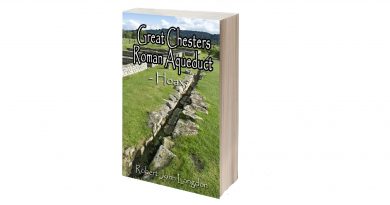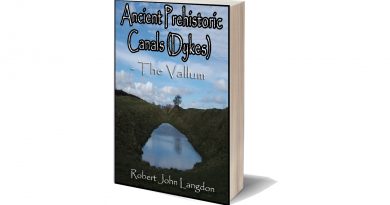Extreme weather and Ancient Subterranean shelters
The UK media over recent years have consistently shown pictures of Extreme weather that have brought a degree of devastation to local communities and individuals. When it comes to flooding, this sensational reporting is usually statistically analysed on the amount of water that has fallen and the wind speed achieved. From time to time, the phrase ‘since records began’ is strategically placed within sentences to reinforce and qualify the severity of the damage we are experiencing or the sub-divide the year into Wettest Summer, Winter, Spring or Autumn. (Extreme weather and Ancient Subterranean shelters)
The reality is that the Meteorological Office that kept these records are based on daily records from 1914. Therefore, to describe any record-busting weather (such as 2012), gives a false view of the weather, which helps feed the ‘climate change’ lobby and a ‘political agenda that has dominated our politics for the last 20 years. Although the England and Wales Precipitation series, which measure rainfall and snow, actually goes back to 1766, and the Central England Temperature series, which covers the temperature from the south Midlands to Lancashire, is the longest-running record in the world, dating from 1659, these records are normally ‘overlooked’ as they are from amateur meteorologists and therefore, ignored.
Here is an extract from 2012 sky news online:
“England and Wales have seen the wettest summer for 100 years, according to MeteoGroup. Rainfall for June, July and August was 362mm (14.25in), making it the wettest summer since 1912. The average summer rainfall across the UK is 226.9mm (8.9in). MeteoGroup forecaster Nick Prebble said this summer is set to be the fourth wettest since records began in 1727. The record for the UK’s wettest summer is 1912 when 384.4mm (15.1in) of rain fell.” (Extreme weather and Ancient Subterranean shelters)

The Met. Office said this summer is also likely to be one of the dullest on record, with just 399 hours of sunshine up to August 28. This would make it the least sunny since 1980, when there were 396 hours of sun. The figures come after unsettled weather over the Bank Holiday weekend that left many UK parts with heavy rain and flood alerts.
Sky News weather producer Joanna Robinson said: “It didn’t start well, with the wettest ever June, and the first half of July was very wet too. After that, the weather settled down a bit, but the end of August has been wet in places. This is because the jet stream position (a narrow band of fast flowing westerly winds high in the atmosphere) over the summer has allowed areas of low pressure to track across the UK, when they would typically be steered further north.”
The UK’s second wettest summer since 1912 was in 2007 when 357.8mm (14.09in) of rain fell. Of the three summer months, August looks set to be the driest and sunniest across the UK, with 105.5mm (4.15in) of rain to August 29, according to the Met Office.
Shock, horror – wettest summer since seven years ago?
This is clear proof that man-made climate change is taking hold – until you look closer at the statistics. For example, let’s take 2007 numbers, number two in the annual precipitation charts. The summer was a statistical washout, but what about annual rainfall for the year – if the media are right, should it be in the top ten all-time highs? Not even close coming in at number 17 in the past 100 years.
The reality is that rainfall has gone up and down quite constantly over the last 250 years, with the most concentrated levels of rain over a 10-year period (which is a mere moment in our history) being in 1870 – 1880, given that between the two most extraordinary rainfall years 2007 and 2012, 2010 was the 11th driest in the last 100 years.
So what about the winds and gales that are ‘changing the landscape’ of our coastline?
Well, again, history can tell another story. Few significant weather events in British history were as devastating as the ‘Grote Mandrenke’, “the great drowning of men,” which occurred in mid-January 1362. A massive southwesterly gale originating in the Atlantic Ocean swept across southern Ireland, Britain, Holland, Belgium and Germany, causing at least 25,000 deaths. In addition, thousands of trees were blown down, and massive damage was caused to the few high buildings that existed in those times, notably churches with spires or towers were destroyed. Most famously, the wooden spire of Norwich Cathedral fell through its roof. (Extreme weather and Ancient Subterranean shelters)
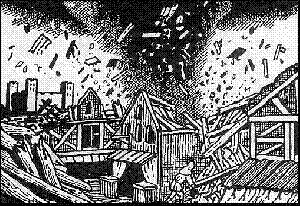
However, worse was to come. As the storm reached the North Sea, it combined with high tides to produce the phenomenon most feared by coastal communities, ‘The storm surge’ Ports all along the East coast of England and across the North Sea in Holland, Germany and Denmark, were destroyed, as the power of the wind and waters changed the shape of the European coastline forever.
However, this devastation is not as unusual as you would imagine and certainly not a ‘one-off off event’.
In the days going back to the first settlers in the Mesolithic period directly after the last ice age, our ancient ancestors had to contend with much more severe weather and harsher conditions. So how do we know this? It’s in the landscape of our countryside for all to see.
When the great melt started after the last ice age, about ten thousand years ago, the amount of water that fell on our land makes the rainfall table look minuscule. The most significant amount of annual rainfall to fall on Britain over the last 250 years is 1300mm (52”); when the ice cap melted 3.2 million millimetres (67,000 inches) swamped the landscape, flooding almost half the landmass, we know today. Some of these waters ran down existing rivers like the Thames and made them ten times wider than today into the lower lands that would become the Irish and North Seas and the English Channel.
The process of this vast water cascading through our landscape created a network of riverbeds and flood plains, which we see flooding today, such as the Somerset flats. However, geology maps show that below the topsoil, lay sediments of sand, silt, and gravel are testament to these ancient paleo-river systems. This is why we see flooding occurring in only certain areas, which the environmental agencies call ‘flood plains’.
The Mesolithic people knew these flood plains well, so when they built their monuments such as Stonehenge and meeting places, they made them on the shorelines of these plains to use the flooded countryside to move from island to island on a boat.
So what evidence is there of these flood plains of the past?
If you study any British Geological Society (BGS) map of Britain, you will notice it shows a series of bedrock, sedimentary and superficial deposits. At a scale of 1:50,000 km and below, these deposits start to form a labyrinth of material that look like canals and gigantic waterways, which lay under the surface on top of the bedrock. This lays testament to how the landscape must have looked at some stage of our natural history, and this is particularly prevalent in the Stonehenge area as well as other chalk bedrock outcrops. (Extreme weather and Ancient Subterranean shelters)
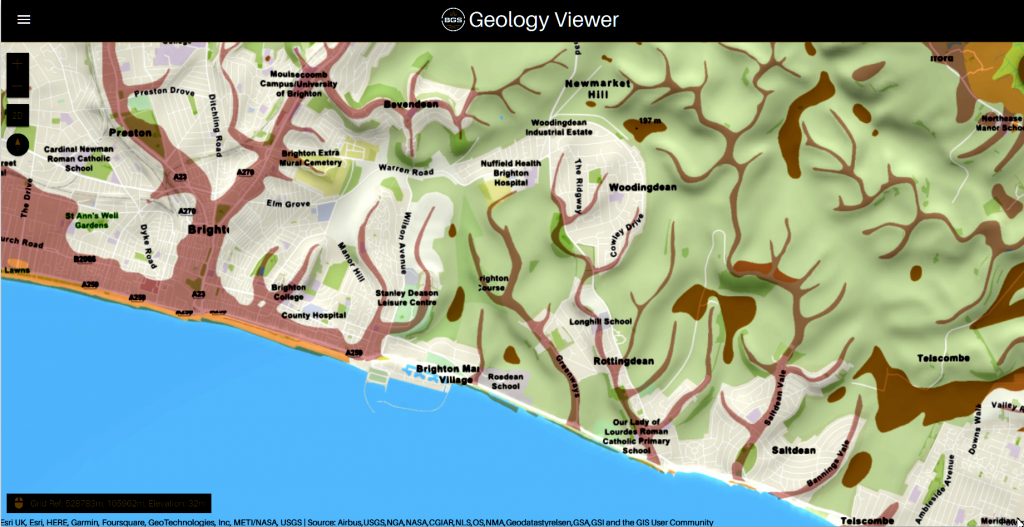
These superficial deposits that resemble ancient rivers can be seen on the surface and are known to the archaeologists, geologists and the general public as ‘Dry River Valleys’ – because the river valleys are currently dry.
However, this was not always the case!
Until recently, geologists believed that the contours of these chalk hills and valleys were cut during a ‘Periglacial Phase’ of the ‘Quaternary Period’, which is the current geological period that started about 2.6 million years ago – although there is no objective evidence of the exact date of their formation.
Theories (and in Geology, new ideas occur regularly) suggest that these dry river valleys are the result of water flooding, washing away the topsoils and rounding the chalk sub-soil during the melting period after an Ice Age.
The problem for archaeologists and geologists is – which one – For there were several during the quaternary period?
Geologists seem content to give rough estimations on the construction date of geological objects such as dry river valleys, which for the archaeologist can become misleading. Nevertheless, the origins of these objects are of some interest, and the actual dates when humanity could have used them are even more critical if we understand the anthropological implications and, through this process, any archaeological findings concerning their locations.
So we must best try to understand not WHEN the dry river valleys were formed, but when LAST did they have water running within them?
Geological maps indicate great rivers once flowed through Britain, and we know that a tremendous deluge of water that has ever affected the landscape is at the end of an ice age, when the gigantic ice caps finally melted, at the end of the last ice age some 17,000 years ago, geologists have estimated that the ice was over two miles thick in some places. This substantial ice level MUST have created huge flooding all over the Mesolithic landscape, including the Valleys of the South Downs, even though they were over 100 miles away from the main ice sheet. (Extreme weather and Ancient Subterranean shelters)
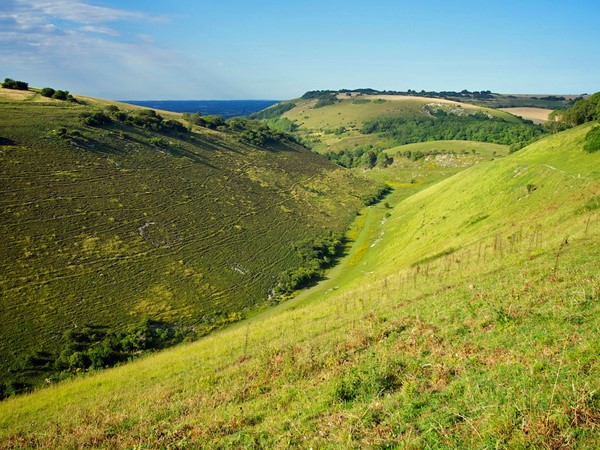
Modern geologists now accept that the dry river valleys are the product of water (not ice as previously believed), and looking at some extreme examples of the soil erosion and valleys cut, we are not talking about just tundra slowly melting in the summer seasons – but millions of gallons of fast-flowing water cutting away at the topsoil and sedimentary deposits, all the way down to the bedrock in some instances.
This geological evidence can clearly be seen in the cliffs and valleys of the South Downs. Just like the Stonehenge region, this area has the same chalk sedimentary bedrock and ancient post-glacial rivers. Evidence for these rivers are found by the subsoil consisting of sand, silt and clay. This subsoil can be seen in the valleys (known as deans) of the South Downs and most graphically in the exposed face of the chalky white cliffs that have been eroded by the sea, giving us a perfect ‘dissection’ of a typical prehistoric waterway. Modern geologists have yet to identify these huge concave sections of the cliffs; as being the remains of the ice melt from the last glaciation which had filled with water leaving the sandy sediments embedded in the chalky sedimentary rock face, just after the great melt, some 15,000 years ago, instead, they claim they are ‘windblown loess’ or ‘wash’ from the valley walls.
What they can’t explain is the relatively short distance from the sandy soil to today’s topsoil and the exact date of this sandy sediment. If you look closely at the cliffs, you will see the sandy remains of the river is touching the topsoil. If this dry river valley was as old as some archaeologists and geologists suggest – where is the rest of the topsoil?
If the topsoil erodes as quickly as some‚ experts’ also suggest – why is there 18 inches of topsoil on top of the chalk today?
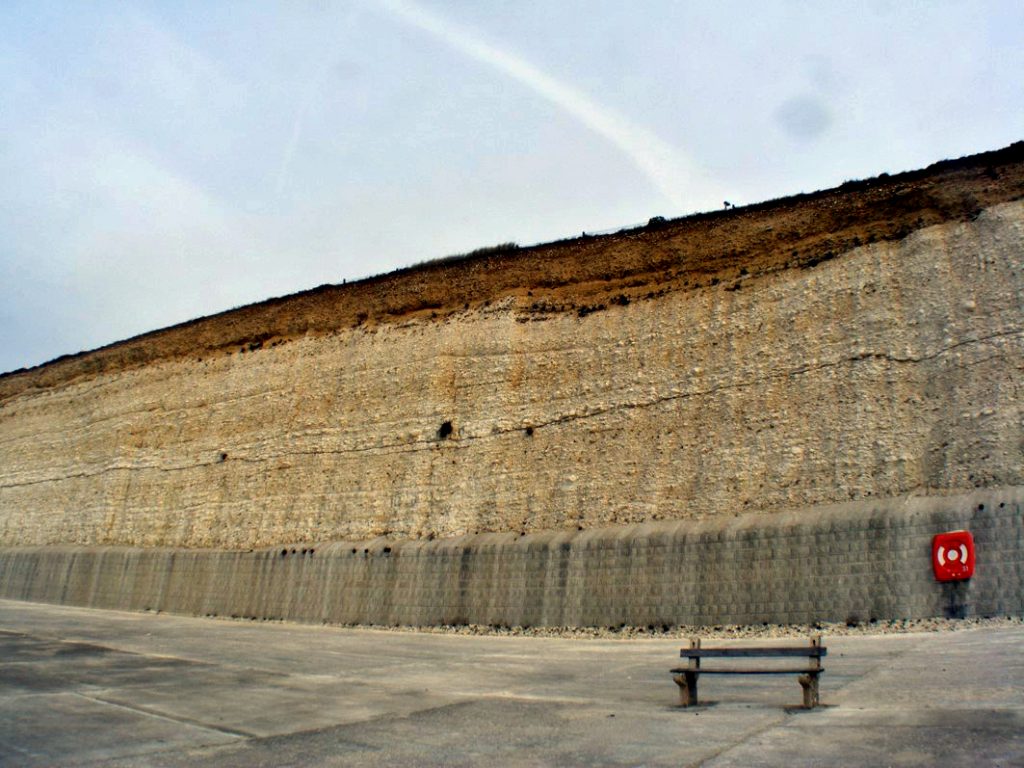
There should be none, or are we expecting some massive climatic event to wipe away the topsoil in the near future? Or is the dating of the prehistoric river beds and, consequently, dry river valleys totally incorrect? However, the evidence of flooding is not just down to the Geology; it can be seen in the construction of the ancient monuments our ancestors built, such as Woodhenge, by a strange-looking site called Durrington Walls.
Durrington Walls
When you look at Durrington Walls, the first thing that strikes you is that it seems incomplete; it looks like a half-circle from aerial photographs, and from the ground you get, a sense of it only being half-finished. However, most illustrations include the easterly section because magnetometer surveys show that there are more ditches under the surface, although you might question their purpose, as it is not apparent. The easterly side of the site was clearly built much later than the original Westside. The East bank is smaller and does not match the initial ditch and moat specifications, which was roughly 5.5 m deep, 7 m wide at its bottom, and 18 m wide at the top. (Extreme weather and Ancient Subterranean shelters)
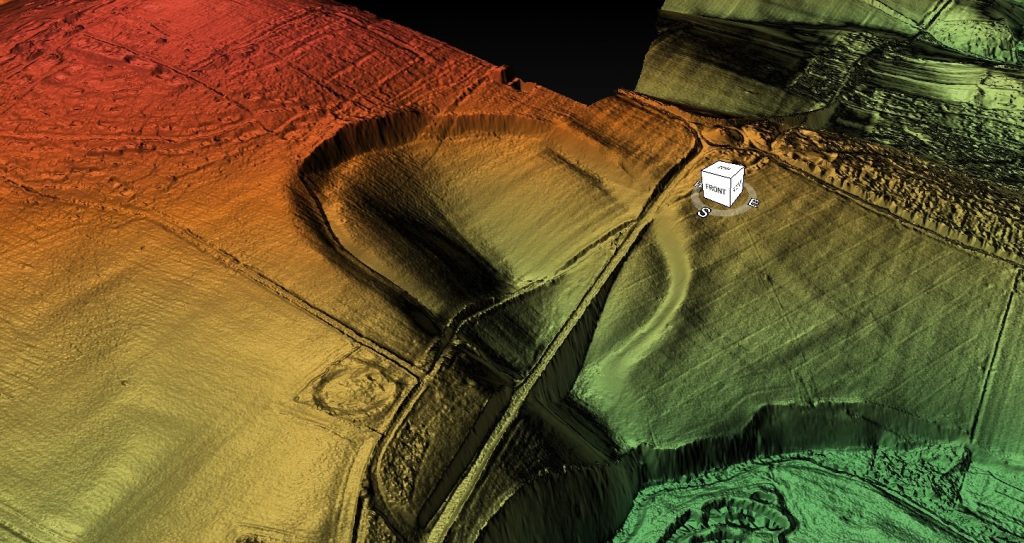
The bank was 30 m wide in some areas. The bank and ditch indicated by the magnetometer surveys are less than half that depth; the bank is only about a third of the size of that on the Northern side. The current theory and plan of Durrington Walls do not stand up to investigation, for clearly, the Eastern side of the camp was added later when the prehistoric groundwater had started to recede.
So what was its original use?
To answer that question, you must look at the site’s terrain, position and layout. The first thing that hits you is that the site is not flat! In fact, it’s a huge bowl.
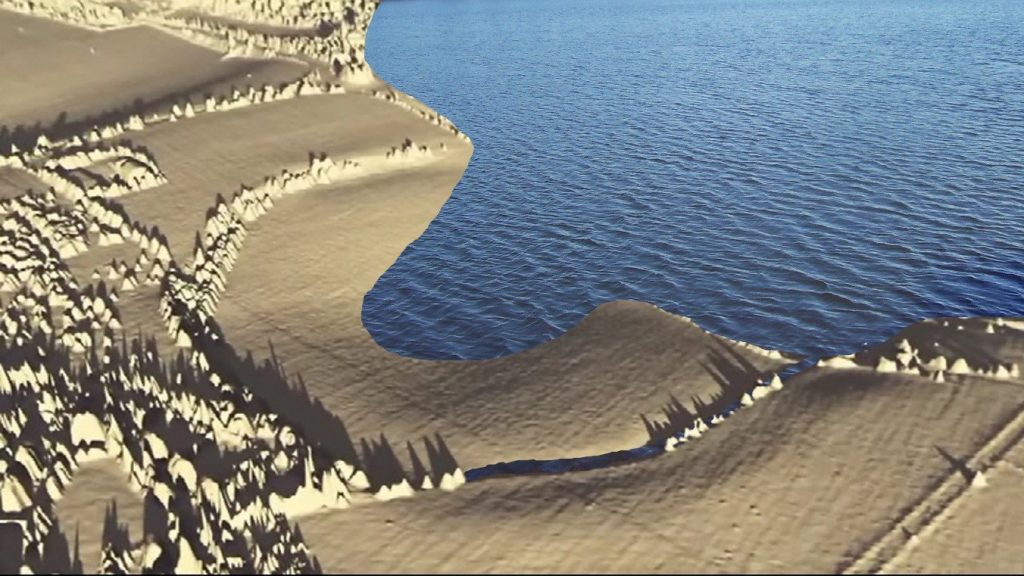
Archaeologists say that it is a settlement, but anyone who goes camping will tell you not to pitch your tent on a slope, and for an excellent reason: you will wake up one morning covered in water, as when it rains, the water runs downhill! So, were our ancestors foolish? If this were an encampment, the houses would frequently flood from the rain.
Archaeologists will insist that, because they have found the foundations of a couple of roundhouses, the site must unquestionably be a settlement – this is because its position and shape dumbfound them. However, if we now add the higher prehistoric groundwater we have suggested, the site becomes a perfect natural harbour, with shallow sides for pulling boats ashore and a four-metre deep ravine in the port centre. Moreover, it still has 3m high external walls even six thousand years after it was abandoned, imagine it when it was first built, and you would be looking at a 5m tall, 30m wide chalk wall – equivalent to any harbour wall we see today that protect our ships from the occasional Gale and storms.
Woodhenge has two entrances: one directed towards Durrington Walls camp and, more importantly, a mysterious second entrance that trails to our ancient shoreline. This is a clear indication that groundwater was present at Woodhenge during prehistoric times. Not only would it explain the strange shape of the camp, but also the magnetometer survey showing a ditch dug after the groundwater had fallen over the years. Even more interesting is how the landscape reflected the receding shoreline over 5,000 years at this site. The present-day minor road runs along the course of the ancient shoreline circa 6,000 BCE
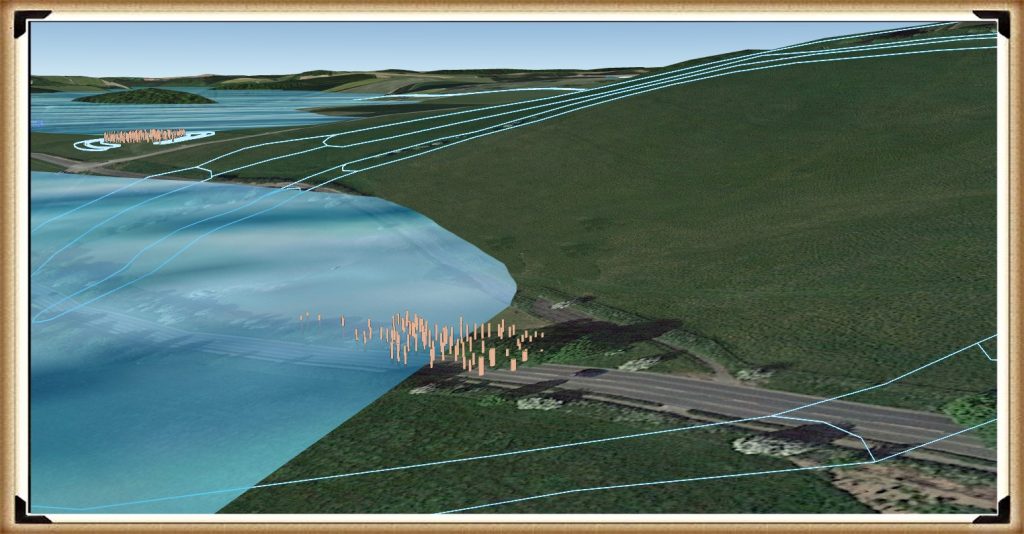
We should not be too surprised by this, as lakeshores and coastlines still have paths along with them today so that we can fully enjoy them. There is no reason to believe that prehistoric people did any different 8,000 years ago, and such a path would also have a practical purpose as the shorelines were used as a mooring site. If we are correct about the road and the mooring points, is it possible to find post holes here under the ground?
Unbelievably, the answer is yes!
Wainwright, in his excavations of Durrington Walls, discovered lots of them. Without a shoreline, the post holes would look random and not make much sense. However, as soon as the groundwater flooding is added, their function becomes apparent: they held mooring posts, as that is the natural landing area for boats coming to and from Stonehenge, Avebury or Old Sarum. But are there other sites that have walls to protect them from the weather?
Avebury
Avebury lies in an area of chalkland in the Upper Kennet Valley, at the Western end of the Berkshire Downs, which forms the catchment for the River Kennet and supports local springs and seasonal watercourses. The monument stands slightly above the local landscape, sitting on a low chalk ridge 160 m (520 ft) above sea level; to the East are the Marlborough Downs, an area of lowland hills. Archaeologists freely admit that the history of Avebury before the construction of the henge is uncertain because little datable evidence has emerged from modern excavations. However, stray finds of flints at Avebury, dated between 7,000 and 4,000 BCE; indicate that the site was visited in the late Mesolithic period.
Post Glacial Flooding ten thousand years ago left a landscape rendered unrecognisable by groundwater, as the Avebury Circle almost becomes an island, with a large freshwater river running to the West of the site. When the groundwater started to recede, our ancestors tried to keep their monument an island by adding ditches with large banks. Current archaeological estimates suggest that it took 1.5 million working hours to build the Avebury monument.
In simple terms, that’s 200 people working full-time for three to four years. Which sadly contradicts another estimation of nearby working hours Silbury Hill, which contains 248,000 cubic metres of chalk, and would have taken 18 million working hours to construct? That’s equivalent to 500 people working full-time for 15 years. However, we are expected to believe that Aveburys 125,000 cubic metres of chalk took just 1.5 million working hours to move. (Extreme weather and Ancient Subterranean shelters)
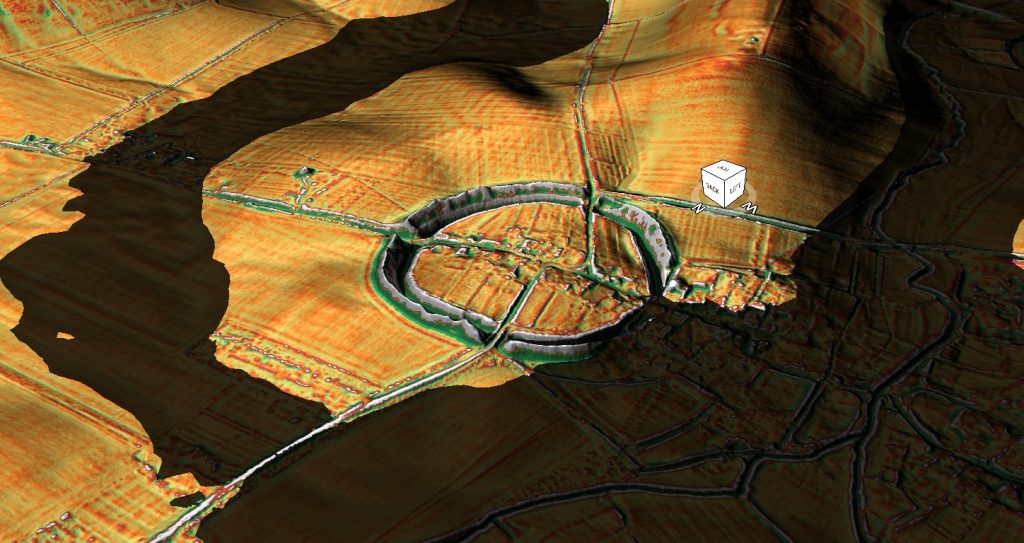
This is just another fact that does not make sense! –
There is just no consistency in archaeological findings; it’s all subjective, and quite frankly, wrong!
It’s more likely that these monuments grew over the course of centuries, slowly but surely, the ditches starting at just one metre but getting deeper over the next 5,000 years as the moat was cleaned out until they reached their final dimensions of 11 metres deep and 22 metres wide. This gradual process would explain another archaeological mystery that the ‘experts’ avoid – with what tools were they built?
Moreover, the most exciting aspect of this excavated ‘chalk mountain’ is that we can use it to understand why it was built. We know the original height of the chalk bank as we know how much chalk was removed from the ditch in front of the mound. On average, the ditch is 11m deep and 22m wide – which means that for every metre excavated, 132m2 was transferred to the bank. The chalk mound is much narrower than the ditch from which it was excavated; therefore, the bank would be higher than the ditches’ depth. My calculation shows that the bank would be, therefore, 15m high at least but as the chalk in the ground had been compressed over time, and the bank would have contained more air gaps, the likelihood is that the bank was 20m high at the time of completion.
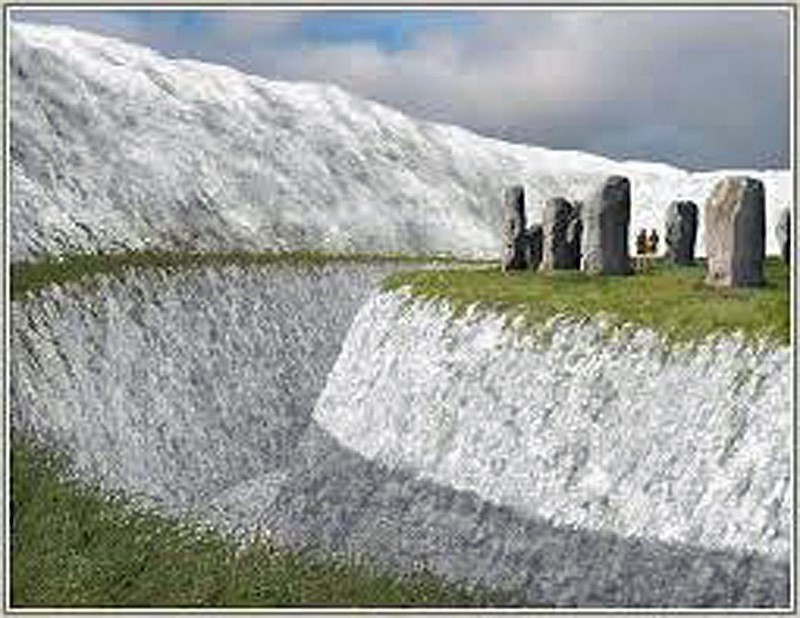
So why take so much time and effort to build a 15m high wall?
Some archaeologists suggest it was a ‘defensive’ feature keeping out marauding tribes. However, the wall is on the wrong side of the ditch and would assist attackers rather than help the defenders of this site. As we have seen just down the road at Durrington, they have placed a high wall on the outside of the interior of the camp to protect boats from the wind and storms, like a modern harbour. Confronted by this paradox, ‘confused‘ archaeologists reverted to the standard theme that these walls were constructed for ‘ceremonial’ reasons. Which I can only imagine has something to do with the God of pointless constructions and practices?
Again as we pointed out at Durrington, these walls are seen in current harbours to protect boats from storms, showing us that our inclement weather is not unique to this current period.
But was the weather much worse than today?
Gales that historically ravaged our lands were probably more significant and more devastating in the past, which can be seen from the shelters they built to shelter from these infrequent storms.
According to Wikipedia
Souterrain (from French ‘sous terrain’, meaning ‘under ground’) is a name given by archaeologists to a type of underground structure associated mainly with the Atlantic Iron Age. These structures appear to have been brought northwards from Gaul during the late Iron Age. Regional names include earth houses, fogous and Pictish houses. The term souterrain has been used as a distinct term from fogou. In Cornwall, the regional name of fogou is applied to souterrain structures. The design of underground structures has been shown to differ among regions; for example, in western Cornwall, the design and function of the fogou appear to correlate with a larder use.
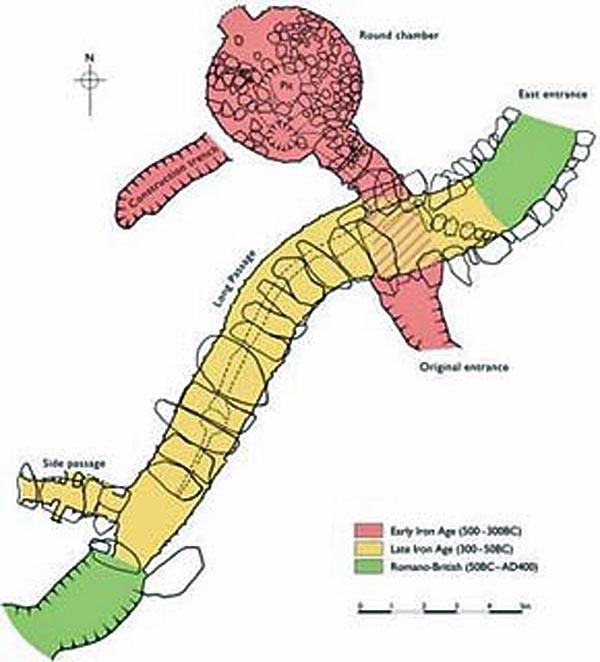
Souterrains are often referred to locally in Ireland simply as ‘caves’. A.T. Lucas, folklorist and Director of the National Museum of Ireland in the 1960s, published a study of the references to souterrains in the early Irish annals. An article by Warner on the archaeology of souterrains, although published 35 years ago, is still possibly the best general overview of the subject. The most comprehensive study of Irish souterrains is Clinton’s 2001 work, containing chapters on distribution, associated settlements, function, finds, chronology and no less than thirteen appendices on various structural aspects of souterrains themselves.
The name comes from the French language, which means “underground passageway.” It is sometimes used to mean ‘basement’ in languages other than English, especially in warehouses.
Souterrains are underground galleries and, in their early stages, were consistently associated with a settlement. The galleries were dug out and then lined with stone slabs or wood before being reburied. In cases where they were cut into the rock, this was not always necessary. They do not appear to have been used for burial or ritual purposes, and it has been suggested that they were food stores or hiding places during times of strife, although some of them would have had very obvious entrances.
In Ireland, they are often found inside or close to a ringfort and are thought to be mainly contemporary with them, making them somewhat later in date than in other countries. This date is reinforced by many examples where ogham stones, dating to around the sixth century, have been reused as roofing lintels or doorposts, most notably at the widened natural limestone fissure at the ‘cave of the cats’ in Rathcrogan. Their distribution is very uneven in Ireland, with the most notable concentration centred on County
The first thing that strikes you as strange is the fact that these landscape features are categorised with different names in different locations:
Earth Houses – Modern use
Fogous – Cornwall
Pictish Houses – Found in Scotland (confusion arises here as some are only partially subterranean) unlike the Earth Houses in the same region.
Caves – Ireland
It’s quite literally an archaeological mess. And the reason for this mess is those archaeologists don’t understand why they were built, so they gave them local names, unlike barrows and Stone circles and henges, which appear in the same areas but with a unified name to save confusion. So how what can we find out about these structures that will help us understand why they were built?
Location, Location, Location
If we look at the minimal archaeological evidence, we do see a defined pattern of construction. For example, in Cornwall, we have found to date a collection of fifteen ‘fogous’. According to archaeologists, this is a proposed use for fogous, a refuge during raiding trips as they are close to the sea. Sadly, if you search deeper, you see them in non-coastal areas and even in the middle of Dartmoor (Lade Hill Brook), where it’s called a Beehive Hut?
The problem with looking for such objects in Devon is that hundreds of ‘caves’ dotted around from the days of tin mining, and therefore an almost impossible to distinguish a prehistoric mine opening from a fogou.
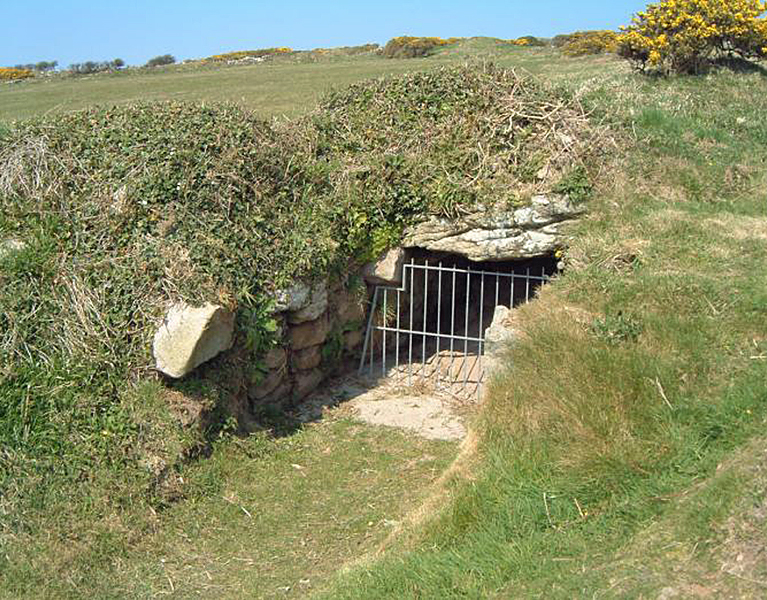
Apart from the extreme South West of Britain, these subterranean shelters do not exist – but what of the coast of Cornwall? In prehistoric times the sea level was some 65m lower than today, and the Isle of Scilly was connected to the mainland – is there anything on these islands that could be considered a fogou?
Carn Gwavel Farm in St Marys is an underground chamber-like corbelled passage that has an `S-shaped’ curve throughout its length, which is 4.97 metres long by 1.18 metres wide and 1.18 metres high. Some roof slabs have collapsed near the northeast end of the passage and lie beneath the present floor surface. At the foot of the northeast, the end wall is a creep that formed the original entrance to the passage. The creep is 0.57 metres wide by 0.27 metres high and extends for 1.36 metres before becoming blocked by fallen debris. The fogou was discovered in May 2000 after a partial collapse of the infill between cover slabs.
The most apparent aspect of Fogous is that they are orientated to the SW-NE alignment – is this religious or a practical necessity?
A typical fogou structure is stone walls, slopping gradually inwards with height to be capped by stone lintels, forming a characteristic trapezoidal cross-section. Similar structures are found in Chamber Cairns, and Passage Chambers, which adds to the confusion as if a body is located in one of these subterranean tunnel’s archaeologists reclassify them.
In Ireland, these subterranean structures are called ‘caves’, and they are reportedly in their thousands. We also find them in Scotland as Earth Houses, although some ‘covered’ houses – not subterranean shelters- have been classified in the same category through archaeological confusion.
We know these classifications are wrong as we know what they were used for, unlike the present archaeologists – their shelters from storms.
Subterranean shelters are found in Cornwall like the isles of Scilly in abundance. But Devon has only one for sure and absolutely nothing in Dorset, Somerset or Wiltshire – where prehistoric structures such as Stone Circles, Henges and Barrows are of most significant numbers. However, we do get them in Ireland and Scotland in even more significant numbers.
But there is a problem – what happened to Wales?
Storms often batter the Welsh coast, yet according to archaeologists, there are no subterranean shelters in this part of the world; if our hypothesis is correct, there should be something similar – and there is; they’re called a Chambered Cairn and Passage Chambers. These features are found all over Wales and are similar drywall stone underground buildings, but they have found dead bodies within them with a difference.
These chambers were built thousands of years ago. Do we believe that they would continue to be used in the same way as they started?
As you drive around Britain’s countryside, you will notice ‘bunkers’ that surround current and abandoned airfields. These bunkers are only 60 years old, yet they have fallen into disuse, and farmers are using them for other purposes – should we be surprised that these subterranean shelters would be used once abandoned for other purposes such as burials?
So the map is now complete; the current storms we see that follow the ‘gulf stream’ have historically moved in from the West and Ireland and/or Cornwall moving up the Irish Sea to Scotland, lashing the Welsh Coastline. This is not new; these are prehistoric storms of which the severity was much more significant than today as the construction of these substantial shelters gives testament.
Similar construction has been seen in other countries that may indicate just how intense these storms were, and these can be found in the hurricane belt of the USA, where residents built subterranean shelters of almost the same size as our prehistoric ancestors. These shelters not only shelter people from hurricanes but the more devastating storms called tornadoes.
In prehistoric Britain directly, the ‘post-glacial flooding’ was caused by record high temperatures in this country – so like Florida today, you had sweltering ground temperatures and the vast amount of cooler water from the flooding, a perfect concoction for the tornado and the need to build substantial subterranean shelters.
But is there any other evidence that tornadoes hit Britain?
On 17th October 1091, London was hit by a vicious tornado.

Historic Records tell us the wooden London Bridge was demolished and 600 houses (primarily wooden). Furthermore, the church at St. Mary-le-bow within the city of London was smashed to pieces with rafters driven more than six metres into the ground. Two men were reported killed, and thousands were made homeless.
One of the great mysteries of Archaeology is the lack of destruction of our greatest monument Stonehenge. It was not completely pulled down, but the gigantic Sarsen Trilithon Stones toppled from a force to the SW of the Monument. It has always been believed that men had tried to pull down the monument for some obscure reason in the past – but why stop at one pair of stones?
If we look at the possibility of tornadoes in Britain, then a ‘strike’ from the South West would be probable, and that would leave the monument with one of the two trilithons felled flat and the other propped up at an angle as Stukeley found in the 16th century and was ‘repaired’ and the turn of the last century.
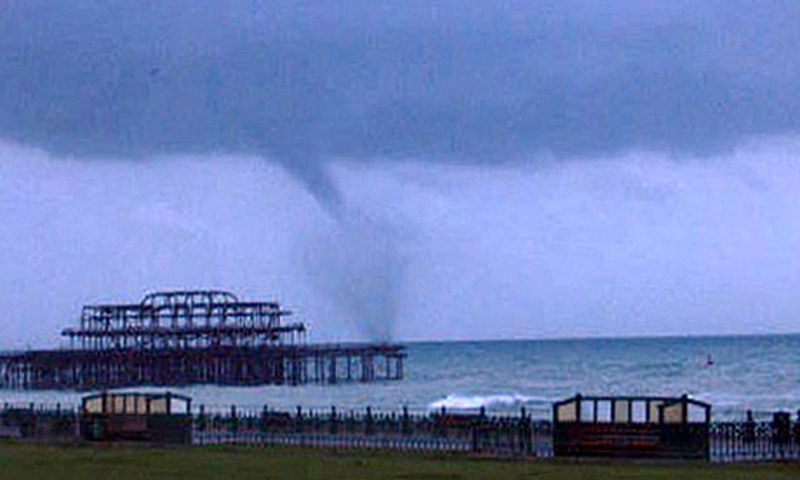
For more information about our history click HERE or visit this video channel HERE.


